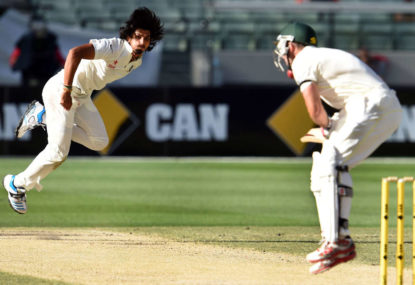Are India selecting themselves out of T20 World Cup glory?
Insanity is doing the same thing repeatedly and expecting different results. This quote is often attributed to Albert Einstein, but nobody knows if he…

India didn’t lose the 2014-15 version of the Border-Gavaskar trophy because of their batting performance. They didn’t lose it because of a lack of leadership, sub-standard fielding or their childish stubbornness on the use of DRS technology.
They didn’t even lose because of their notoriously atrocious touring attitude.
No, the root cause of Australia’s unassailable 2-0 series lead is India’s pathetic pop-gun bowling unit, so often their achilles heel away from the comforts of the subcontinent.
The long-thought theory in Test cricket that bowlers win matches may not ring entirely true anymore, but bowling well as a unit still holds weight when it comes to winning.
Australia, South Africa and even England a few years ago proved us that much. But India just don’t seem to learn their lessons.
They lack mongrel with the cherry in hand, bereft of aggression except for short spurts when their quicks huff and puff, full of false bravado, before realising their charade is as easy to see through as a pair of arseless chaps.
I’m struggling to recall a bowling attack that errs more in line and length and lets games slip away with poor, ill-thought out bowling plans such as the ridiculous first session in Adelaide where David Warner punished India for their uninspired around-the-wicket tactics.
In fact, there’s about five examples of such tactics in this series alone.
India employed short-ball bowling, and poorly, to an out of form Brad Haddin for too long, and sledged Mitchell Johnson, kicking the sleeping dogs that dragged Australia back into two matches.
Part of that rests on the now-retired MS Dhoni, but honestly there’s been just as many instances of Australians throwing away their wicket as the Indians earning them.
Ryan Harris may be a handy lower-order player, but the fact he scored 95 runs in two innings (27 more than Dhoni’s haul from four innings) is indicative of India’s insipidness with ball in hand.
And until the BCCI does something about India’s woeful fast-bowling stocks and development, they will be left to languish in the dull afterglow away from cricket’s centre stage.
Because for the Indians, batting has never really been issue since they began their ascent into world-cricket relevance a few decades ago. Save for the embarrassing tour of 2011-12, when India’s old guard had hung around too long, their batting performance is normally streaks ahead of their bowling.
It is their fast bowling that has, and seemingly always will, deny them access from the lucrative upper-tier of Test cricket. It’s almost tragic comedy that a nation of one billion has produced one, maybe two world-class quicks in its cricket story.
While Zaheer Khan could be a very dangerous bowler, India has been lacking a true demolition man in their attack since Kapil Dev left the Test arena with a then world record 434 wickets.
In this series alone, India has bowled Australia out just twice, for first innings scores of 505 and 530, and the pace battery has leaked an astonishing 1554 runs for their 33 wickets. Mohammed Shami awkwardly boasts the best figures of the summer, a sheepish 4-138 in which he was punished for 23 boundaries and watched as Steve Smith played the knock of the summer.
It must be frustrating for Virat Kohli, Murali Vijay and Ajinkya Rahane, who with a combined run tally of 1249 have scored 305 less runs than their fast bowlers have conceded.
It must have been frustrating back in 2007-08 too, when Sachin Tendulkar and VVS Laxman finished second and fourth respectively among the top runscorers while Ishant Sharma and Khan managed only 11 wickets between them.
What’s worse, the fact India’s fast bowlers leaked a whopping 5958 runs in their last four Australian tours, or that they only claimed 94 wickets out of a possible 270 and failed to dismiss Australia on six occasions?
India spent nearly two years atop the Test rankings between December 2009 and August 2011 despite their high percentage of drawn Tests, trailing only England over the last 10 years in that category.
Perhaps it’s telling that India draw so many Tests, even at home, when you consider their inability to bowl opposing sides out. In the last 10 years, India have failed to dismiss their opponent 24 per cent of the time in the 104 Test matches they’ve played.
And while India’s crumbly clay decks have always suited spinners, it’s still alarming that their turners have in fact taken more wickets (859) to fast-bowlers and medium-pacers (801) since 2005.
Regardless of their skill, every side needs a cohesive fast-bowling unit that can bust through the door to claim vital wickets when needed. Every Test playing nation has its traditional strengths and weaknesses but there are exceptions to every rule.
Pakistan produced two of the best bowlers of their generation in Waqar Younis and Wasim Akram despite growing up on tracks that generally offered little assistance. Australia produced the greatest spinner of all-time in Shane Warne, despite playing on surfaces that generally didn’t assist spin until day five.
In the current cricket environment, where teams travel so often and techniques and roles are constantly changing, it is India’s turn to offer up something outside the box.
We’re used to the dead-eyed hitters and the nifty spinners, but in order for India to be a consistent threat in Test cricket, it’s time for them to muster up a pace attack with at least a hint of venom.